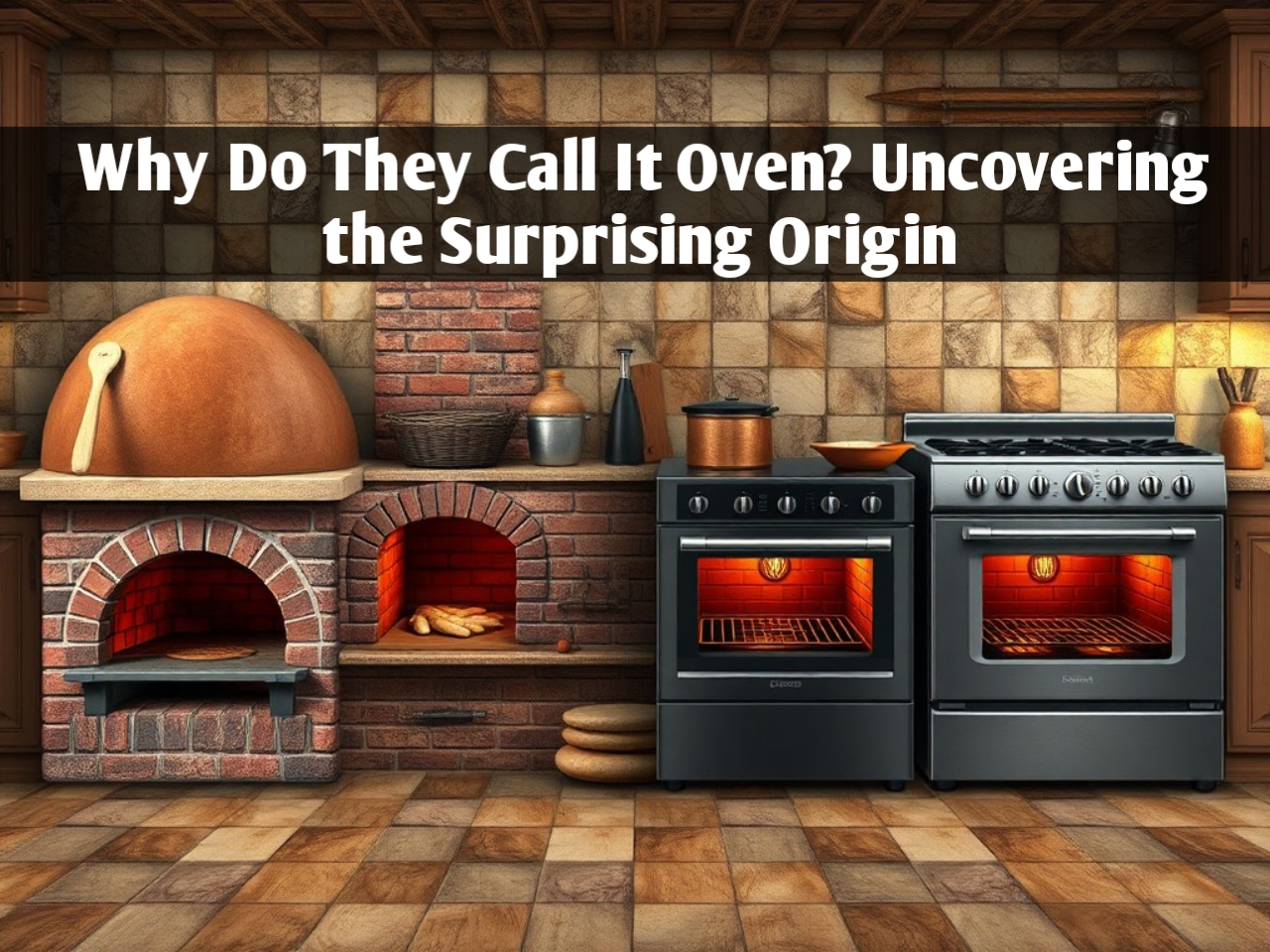Why Do They Call It Oven? Uncovering the Surprising Origin
The word “oven” is one of the most commonly used terms in kitchens worldwide. While most people use this appliance regularly, few have paused to wonder about its name’s origin. Where did the word “oven” come from? Why do we call it an “oven” rather than something else? This article delves deep into the fascinating history, etymology, and evolution of the word “oven,” tracing its journey through ancient times, its linguistic roots, and its role in culinary history.
The Ancient Origins of Cooking and Baking
Cooking has been an integral part of human civilization since prehistoric times. The earliest humans discovered that cooking food not only made it more palatable but also made it easier to digest and more nutritious. Before the advent of modern ovens, our ancestors relied on rudimentary methods of cooking, such as open fire pits and heated stones. The evolution of cooking methods paved the way for the development of enclosed cooking spaces, which eventually led to the invention of ovens.
Archaeological evidence suggests that the earliest ovens date back to ancient civilizations such as the Egyptians, Greeks, and Romans. These early ovens were often simple clay structures used to bake bread, a staple food in many societies. The need for consistent heat and the desire to improve the efficiency of cooking led to the gradual refinement of oven designs. But why did they start calling these enclosed cooking structures “ovens”?
Etymology of the Word “Oven”
To understand why they call it an oven, we must first explore the etymology of the word itself. The word “oven” has its roots in Old English, specifically from the word “ofen.” This term, in turn, was derived from the Proto-Germanic word “ubniz,” which referred to a heated chamber used for cooking or baking. If we go further back, the term can be traced to the Proto-Indo-European root aupo, which means “to cook” or “to bake.”
The transition of this term through different languages reflects the cultural importance of baking and cooking throughout human history. From ancient times, people recognized the need for a space where food could be cooked evenly and safely, leading to the development of various forms of ovens. The name stuck, and as ovens evolved, so did the language surrounding them.
Early Ovens: From Clay Structures to Advanced Technology
Before we dive further into the word “oven,” it’s important to understand what early ovens were like. Early ovens, as used by the Egyptians, were simple structures made from clay and often built into the ground. These early models were used primarily for baking bread, which was an essential foodstuff in ancient civilizations. The design was basic, but it fulfilled the purpose of evenly distributing heat around the food being baked.
The Greeks and Romans later improved on the design, developing more advanced versions that included dome-shaped ovens and brick structures. These ovens were more efficient and allowed for greater temperature control, expanding their use beyond just baking bread to cooking meat, fish, and other types of food. With these developments, the idea of the oven as an enclosed space dedicated to cooking was solidified.
The Transition to the Modern Oven: A Key Moment in Culinary History
Ovens underwent significant changes during the Middle Ages and the Renaissance. The invention of the wood-burning oven became popular in Europe during this time, allowing for greater control over cooking temperatures. These ovens were often built inside homes and featured a more permanent structure, contributing to the word “oven” becoming synonymous with an enclosed cooking space.
It wasn’t until the 18th and 19th centuries that ovens began to take on the more recognizable forms we see today. The introduction of cast iron and, later, the development of gas and electric ovens revolutionized cooking. These advances allowed for greater consistency in heating, precision in temperature control, and more versatility in cooking methods.
As ovens continued to evolve, the word “oven” remained a consistent term to describe these cooking devices. But why did this specific word endure when other cooking methods, like stovetop frying or grilling, developed their own distinct terms? The answer lies in the cultural and linguistic significance of the term.
The Cultural Significance of Ovens in Human History
Ovens have played a significant role in human society, particularly in how we gather and share food. Baking, for example, has been a communal activity for thousands of years. In many ancient cultures, large community ovens were used to bake bread for entire villages or communities. This made the oven a focal point for social and cultural interaction.
The term “oven” not only referred to a specific appliance but also became associated with warmth, home, and family. The idea of “breaking bread” together is a metaphor rooted in the communal use of ovens throughout history. Even in modern times, the oven is seen as a central component of family kitchens, often used to prepare meals during important gatherings and celebrations.
Linguistic Consistency: Why “Oven” Has Stood the Test of Time
Language evolves over time, often adapting to new technologies, cultural practices, and social changes. The fact that we still use the term “oven” today, despite the introduction of new cooking appliances like microwaves and air fryers, demonstrates the staying power of certain words. While we have distinct names for different methods of cooking (e.g., grilling, frying, roasting), the term “oven” has remained consistent for centuries.
Part of this linguistic consistency can be attributed to the fact that ovens serve a unique function. Unlike stovetops or grills, ovens provide an enclosed space where heat can be evenly distributed around food. This specific method of cooking—enclosed heat—has remained largely unchanged, even as the technology behind ovens has advanced. As a result, the word “oven” has endured as the most accurate term to describe this type of cooking appliance.
Ovens in Different Languages: A Global Perspective
While the English word “oven” has its roots in Old English and Proto-Germanic, other languages have their own terms for ovens, many of which share similar linguistic roots. For example:
- In German, the word for oven is “Ofen,” closely related to the Old English “ofen.”
- In French, the word is “four,” derived from the Latin word “fornus.”
- In Italian, it’s “forno,” also from the Latin “fornus.”
- In Spanish, the word is “horno,” once again tracing its origin back to Latin.
These linguistic similarities highlight the shared cultural importance of ovens across different societies. The fact that many of these terms are derived from a common Proto-Indo-European root underscores the universality of cooking and baking as essential human activities.
The Role of Ovens in Modern Kitchens
Today, ovens have become indispensable appliances in kitchens around the world. Whether you’re baking bread, roasting a turkey, or simply reheating leftovers, ovens play a crucial role in modern cooking. The technology behind ovens has advanced significantly, with the introduction of convection ovens, microwave ovens, and smart ovens that can be controlled remotely via smartphone apps. Despite these technological advancements, the basic function of the oven—enclosed cooking with evenly distributed heat—has remained the same.
The continued use of the word “oven” in modern times reflects not only its historical roots but also its adaptability to new cooking technologies. Whether it’s a wood-fired oven in a traditional pizzeria or a high-tech smart oven in a modern home, the term “oven” continues to represent the idea of an enclosed cooking space.
Conclusion: Why Do They Call It Oven?
So, why do they call it an oven? The answer lies in the word’s deep linguistic roots, tracing back to ancient times when early humans first began experimenting with cooking methods. The term has evolved alongside ovens themselves, but it has remained consistent in its meaning. Ovens have always provided a unique, enclosed cooking environment that differentiates them from other cooking methods.
The word “oven” has endured through centuries of language evolution and technological advancements because it perfectly encapsulates the function and importance of this essential kitchen appliance. From ancient clay structures to modern electric ovens, the concept of the oven—and the word we use to describe it—has remained remarkably consistent, highlighting its central role in human culinary history.
Read Also Our This Post: W5233 Moonlight Way, Elk: Inside the Largest Home Sale in the Area

Kamran Khatri is a versatile writer and editor at ExpressZone.co.uk, bringing fresh perspectives and insightful commentary across a wide range of topics. With a passion for exploring diverse subjects—from technology, business, and finance to lifestyle, travel, and the arts—Kamran aims to inform, inspire, and engage readers through well-researched articles and thought-provoking content.
His work spans multiple categories including health, education, pets, entertainment, real estate, and sustainability, reflecting his commitment to delivering knowledge that connects with everyday life. Whether breaking down the latest trends, sharing practical tips, or highlighting cultural insights, Kamran’s writing combines clarity with creativity.
When he’s not crafting stories for ExpressZone.co.uk, Kamran enjoys keeping up with global developments, exploring innovative ideas, and connecting with readers who share his curiosity about the world.







